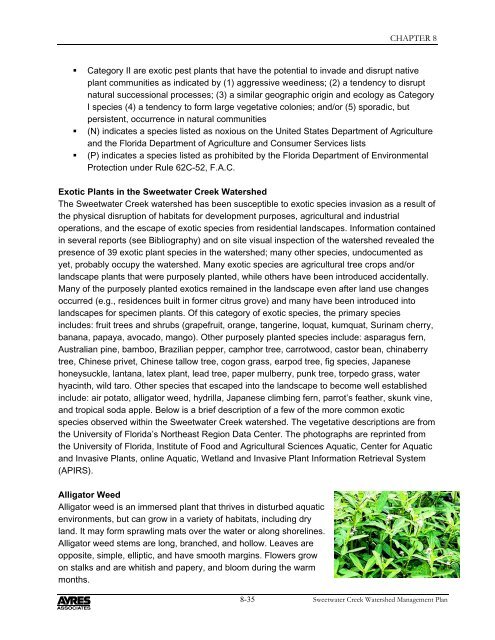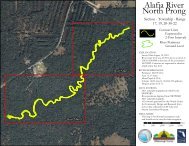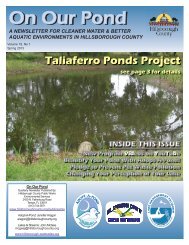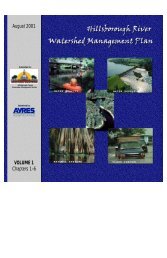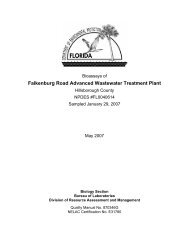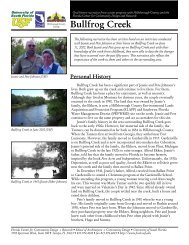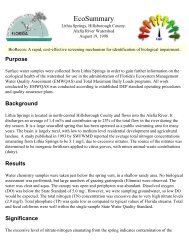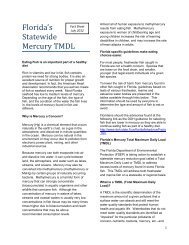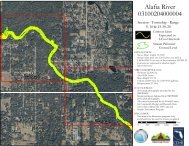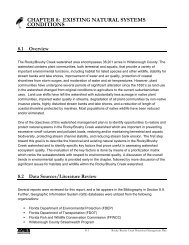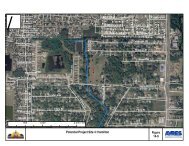Sweetwater Creek Watershed Mgmt. Plan 2007 Update--Part 2
Sweetwater Creek Watershed Mgmt. Plan 2007 Update--Part 2
Sweetwater Creek Watershed Mgmt. Plan 2007 Update--Part 2
You also want an ePaper? Increase the reach of your titles
YUMPU automatically turns print PDFs into web optimized ePapers that Google loves.
CHAPTER 8<br />
• Category II are exotic pest plants that have the potential to invade and disrupt native<br />
plant communities as indicated by (1) aggressive weediness; (2) a tendency to disrupt<br />
natural successional processes; (3) a similar geographic origin and ecology as Category<br />
I species (4) a tendency to form large vegetative colonies; and/or (5) sporadic, but<br />
persistent, occurrence in natural communities<br />
• (N) indicates a species listed as noxious on the United States Department of Agriculture<br />
and the Florida Department of Agriculture and Consumer Services lists<br />
• (P) indicates a species listed as prohibited by the Florida Department of Environmental<br />
Protection under Rule 62C-52, F.A.C.<br />
Exotic <strong>Plan</strong>ts in the <strong>Sweetwater</strong> <strong>Creek</strong> <strong>Watershed</strong><br />
The <strong>Sweetwater</strong> <strong>Creek</strong> watershed has been susceptible to exotic species invasion as a result of<br />
the physical disruption of habitats for development purposes, agricultural and industrial<br />
operations, and the escape of exotic species from residential landscapes. Information contained<br />
in several reports (see Bibliography) and on site visual inspection of the watershed revealed the<br />
presence of 39 exotic plant species in the watershed; many other species, undocumented as<br />
yet, probably occupy the watershed. Many exotic species are agricultural tree crops and/or<br />
landscape plants that were purposely planted, while others have been introduced accidentally.<br />
Many of the purposely planted exotics remained in the landscape even after land use changes<br />
occurred (e.g., residences built in former citrus grove) and many have been introduced into<br />
landscapes for specimen plants. Of this category of exotic species, the primary species<br />
includes: fruit trees and shrubs (grapefruit, orange, tangerine, loquat, kumquat, Surinam cherry,<br />
banana, papaya, avocado, mango). Other purposely planted species include: asparagus fern,<br />
Australian pine, bamboo, Brazilian pepper, camphor tree, carrotwood, castor bean, chinaberry<br />
tree, Chinese privet, Chinese tallow tree, cogon grass, earpod tree, fig species, Japanese<br />
honeysuckle, lantana, latex plant, lead tree, paper mulberry, punk tree, torpedo grass, water<br />
hyacinth, wild taro. Other species that escaped into the landscape to become well established<br />
include: air potato, alligator weed, hydrilla, Japanese climbing fern, parrot’s feather, skunk vine,<br />
and tropical soda apple. Below is a brief description of a few of the more common exotic<br />
species observed within the <strong>Sweetwater</strong> <strong>Creek</strong> watershed. The vegetative descriptions are from<br />
the University of Florida’s Northeast Region Data Center. The photographs are reprinted from<br />
the University of Florida, Institute of Food and Agricultural Sciences Aquatic, Center for Aquatic<br />
and Invasive <strong>Plan</strong>ts, online Aquatic, Wetland and Invasive <strong>Plan</strong>t Information Retrieval System<br />
(APIRS).<br />
Alligator Weed<br />
Alligator weed is an immersed plant that thrives in disturbed aquatic<br />
environments, but can grow in a variety of habitats, including dry<br />
land. It may form sprawling mats over the water or along shorelines.<br />
Alligator weed stems are long, branched, and hollow. Leaves are<br />
opposite, simple, elliptic, and have smooth margins. Flowers grow<br />
on stalks and are whitish and papery, and bloom during the warm<br />
months.<br />
8-35<br />
<strong>Sweetwater</strong> <strong>Creek</strong> <strong>Watershed</strong> Management <strong>Plan</strong>


